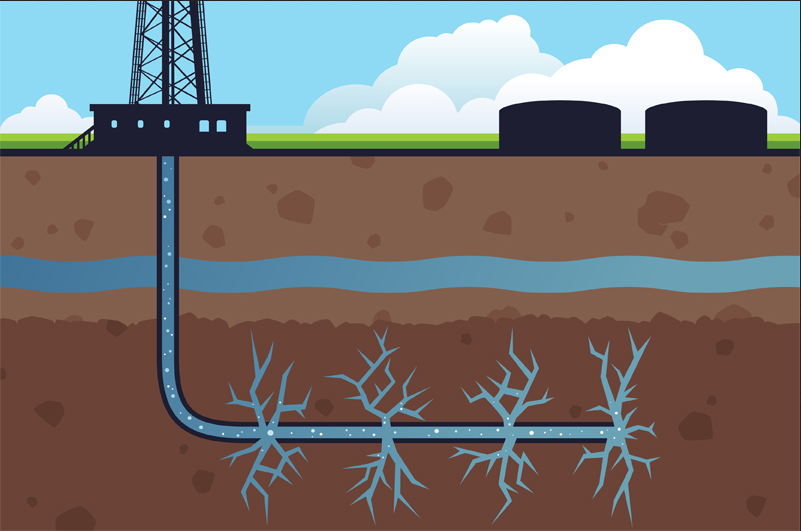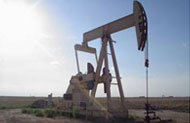Natural Gas
As natural gas is the gas component of coal and oil formation, it is used in industrial and commercial heating and cooking. In a compressed form, natural gas can be used as transportation fuel. Texas is one of the five states that hold more than 85% of U.S.natural gas reserves (the others include Louisiana, Alaska, New Mexico, and Oklahoma).
Wells for natural gas are drilled in underground reservoirs of porous rock. Natural gas can rither be pumped to the processing station for removal of liquid hydrocarbons when it is removed from a reservoir.
You can learn more about the fossil fuels here.
 The Eagle Ford Shale is a 400-mile long, 40-mile wide deep formation of tight rock that stretches from East Texas south below San Antonio to Mexico. At first the Eagle Ford Shale was not a moneymaking business until a horizontal drilling came on the scene combined with the recent advances in hydraulic fracturing. Meaning that all the oil and gas that could not be removed now could be. According to Pioneer Natural Resources, it’s possible that about 25 billion barrels of oil and natural gas below it’s surface. However, it has not been proved. Learn More…
The Eagle Ford Shale is a 400-mile long, 40-mile wide deep formation of tight rock that stretches from East Texas south below San Antonio to Mexico. At first the Eagle Ford Shale was not a moneymaking business until a horizontal drilling came on the scene combined with the recent advances in hydraulic fracturing. Meaning that all the oil and gas that could not be removed now could be. According to Pioneer Natural Resources, it’s possible that about 25 billion barrels of oil and natural gas below it’s surface. However, it has not been proved. Learn More…
Environmental Costs Missing From Eagle Ford Shale Reports
A new economic impact study by UTSA’s Center for Community and Business Research (CCBR) is a real attention-getter: It concludes that activity in the Eagle Ford Shale play totaled a whopping $61 billion in 2012. But the report doesn’t tell the whole story. [Click here to download the CCBR document.]
Presented in Tuesday in Austin and Thursday in San Antonio, the study is the latest in a string of releases, including a 155-page report issued two weeks ago by the Texas Eagle Ford Shale Task Force, that measures the massive expansion of oil and gas drilling and its direct and indirect impact on local economies throughout South Texas.
However, these studies are not measuring the external costs of environmental damage, the use and loss of scarce groundwater, and the long-term impact of fossil fuel use and climate change. Read more at the Rivard Report…
 Eagle Ford Forum II: Sustaining the Boom and Averting the Bust
Eagle Ford Forum II: Sustaining the Boom and Averting the Bust
The Eagle Ford, now the world’s most active shale play, has quickly grown to be an oil and gas boom beyond the region’s wildest expectations. Companies are investing billions of dollars annually, tens of thousands of good jobs are being created, and one of the nation’s poorest and most neglected regions is on the cusp of transformation.
The boom, one industry leader confidently declared, will continue for years.
Texas is once again the nation’s number one oil producer, producing more than the next three states – Alaska, California and North Dakota combined. That, coupled with the potential of expanding domestic use of cheap natural gas, offers the country an unprecedented opportunity to move closer to energy independence.
But challenges seem equally large: Badly stressed-cities and counties will need billions of dollars in investment to alleviate the strain on infrastructure: roads, acute housing shortages, and inadequate health care and medical facilities, and underfunded higher education. Read more at the Rivard Report…
Oil
Oil comes from crude oil, which is made up of hydrocarbons with some oxygen, nitrogen, and sulfer impurities. Most of the crude oil can be found in the Middle East, where 63% of the reserves are known. The oil that is consumed in the U.S. is mostly used in trasportation.
Oil can be obtained in basically three ways:
- About 30% of the oil can be recovered by pumping.
- Another 10% can be recovered by flodding the well with high-pressure water or gas.
- The third way (which is another 30%) is to heat the oil to scrub it out.
The other half of the oil is trapped in the rock. Everyday oil producers are seeking economical ways to recover more of this oil.
The oil refining process separates crude oil into different hydrocarbons and removes impurities such as sulfur, nitrogen, and heavy metals. Here's the process:
- Fractional Distillation – In a tall tower (called a fractionating column), crude oil is heated until it boils and vaporizes. Each hydrocarbon rises to a tray at a temperature just below its own boiling point. Then, it cools and turns into a liquid again.
- The refining process then continues, with heavy fractions converted into lighter fractions.
Coal
Coal is mostly made up of caron. The United States uses coal to generate more than half of the electricity produced. Coal is obatined by surface or deep mining, and the U.S. exports mostly to Western Europe, Canada, and Japan. Deep mining includes digging shafts and tunnels to get to coal seam. Coal can be gasified to form a synthetic fuel similar to natural gas and can also be liquifed.

Comments
Fossil Fuels (Gas, Oil & Coal) — No Comments
HTML tags allowed in your comment: <a href="" title=""> <abbr title=""> <acronym title=""> <b> <blockquote cite=""> <cite> <code> <del datetime=""> <em> <i> <q cite=""> <s> <strike> <strong>